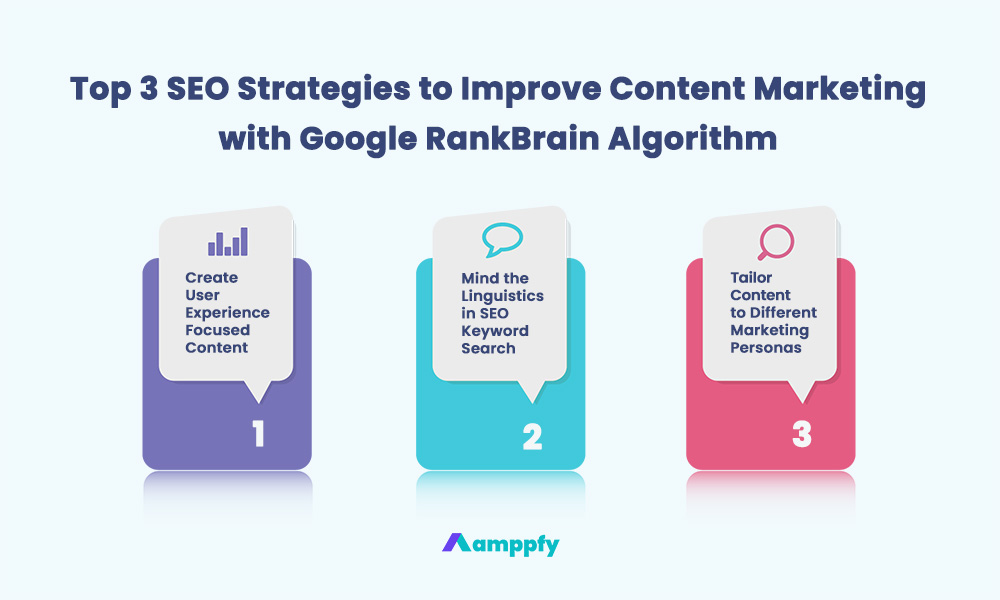RankBrain is one of Google’s milestone search algorithms with AI/ML (Artificial Intelligence and Machine Learning). Google uses AI/ML algorithms to intuitively interpret the intent behind search phrases to return more accurate results and improve the online search user experience. The goal is to build meaningful connections between search queries and the true user intent behind keywords.
How Google RankBrain Update Affects Search
Google RankBrain algorithm is only one piece of the overall SEO algorithm puzzle that predicts and determines website ranking for keywords. The search criteria do not change but become more refined and intuitive as new algorithms are introduced into the formula.
Google RankBrain Update Creates Organic Search Ranking Opportunities
Treat Google RankBrain as an opportunity to identify potential customers and open up new markets by optimizing your website with keywords that increase ranking. RankBrain improves search by better understanding conversational or everyday vocabulary used in human interactions. That means RankBrain “thinks” to relate intent to words used in the search terms.
Google RankBrain Example 1:
When someone searches “Apple phone,” Google will understand that the word “apple” does not mean the actual fruit but instead the company “Apple.” The term “phone” means a cellular device, not a traditional telephone.
Google RankBrain Example 2:
When someone searches for a particular street address with parking information, Google will locate the specific street and include additional detail on parking hours and local parking restrictions.
How e-Commerce and B2C Businesses Leverage Google RankBrain Algorithm to Increase Online Demand
RankBrain algorithm is especially advantageous when ranking keywords across product or service webpages for e-commerce or B2C (Business-to-Consumer) websites. You can include a broad spectrum of long-tail keywords (keyword-containing search phrases) in product or service titles and descriptions. When the webpage content is specific and relevant, the more potential these pages have to be picked up by Google to match search queries from visitors that fit within your ICP (Ideal Customer Profile).
Example of How Google RankBrain Update Increases Online Demand for B2C Businesses
Let’s say you sell espresso coffee machines on an e-commerce website. What additional detail can you incorporate to enhance the product title and description of the espresso machines to improve SEO marketing and rank higher in search?
Here are a few quick examples of incorporating long-tail keywords to drive online demand for e-commerce businesses.
Incorporate Long-tail Keywords to Improve E-Commerce Product Search Ranking
For example:
- The espresso machine grinds coffee beans.
- The coffee machine froths milk.
- An all-in-one espresso machine for coffee connoisseurs.
- Makes espresso and coffee in less than 30 seconds.
The Goal:
When the product landing pages rank high for specific keywords in search results, online demand and sales conversion opportunities increase organically on your e-commerce website.
How B2B Businesses Leverage Google RankBrain Algorithm to Increase Online Demand
For B2B (Business-to-Business) websites, use Google’s RankBrain algorithm to boost product or service solution page rankings with keyword-optimized titles and descriptions. The more detail you can expand on the solution features, the more relevant traffic your website receives from visitors who fit your ICP (Ideal Customer Profile).
Example of How Google RankBrain Update Increases Online Demand for B2B Businesses
Let’s say you are marketing a graphic design service business. Besides writing features, competitive advantage, and benefit statements, consider adding keywords about the unique aspects of your service.
Incorporate Long-Tail Keywords to Improve B2B Solution Page Search Ranking
For example:
- Mention various graphic software you have expertise in.
- Create an ROI (Return on Investment) calculation for your service.
- Include free resources, including whitepapers, ebooks, blogs, or pre-recorded on-demand webinars to help prospects choose your service over competitors.
The Goal:
The goal is to continue enhancing the product or service solution page with relevant content to convert visitors into customers.
Top 3 SEO Strategies to Improve Content Marketing with Google RankBrain Algorithm

#1. Create User Experience Focused Content
Quality content is your best bet, no matter what algorithm Google spins out next. Content optimization should be the primary SEO strategy because it significantly impacts a website’s keyword ranking.
Content is the Most Significant Search Ranking Factor
As Google mentioned to Search Engine Land, content is still the most significant factor influencing search ranking. Why? Because helping people find relevant, insightful, and helpful content is the core focus behind Google search.
Google RankBrain Cares about User Experience
UX or User Experience focused content fulfills the purpose of search and helps websites rank with Google RankBrain. Create content with user experience in mind that answers questions visitors are searching for.
Follow our complete guide on effective SEO content marketing strategies on how to improve visitor engagement and boost keyword search ranking.
#2. Mind The Linguistics in SEO Keyword Search
Google RankBrain algorithm affects how we do keyword research, which is another vital part of the overarching SEO content optimization strategy. RankBrain enhances the way keyword research is done by making it more intuitive and conversational. Learn more about SEO keyword research.
Learn How Google RankBrain Interprets User Intent
To learn how RankBrain thinks and interprets user intent, we need to understand what keywords or phrases visitors use to search for products and services. This information is available in Google Search Console. Look for connections between the keywords visitors use during searches and the content being viewed on your website.
How to Leverage Keyword Research Tools to Uncover Intent-Based Keywords
Google RankBrain opens up new opportunities for a website to rank higher by having fully optimized content with relevant and intent-based keywords. More advanced tools like Semrush can uncover more lucrative niche opportunities with long-tail keywords and discover keywords your competitors are ranking for.
Try keyword search for free here.
#3. Tailor Content to Different Marketing Personas
Marketing personas are hypothetical representations of your potential customers on how they interact with your product or service. How does marketing persona help with Google RankBrain algorithm? It identifies how a group of like-minded visitors relate to your product or service, so you can create content that matches the needs of different persona groups.
Example of How to Tailor Content to a Specific Marketing Persona
For example, suppose a marketing persona for a group of visitors is price sensitive. The product title and description or service solution page should contain keywords that resonate with the particular group.
Here are examples of using relevant keywords to tailor to a specific marketing persona.
5 Examples of Keywords for Price-Sensitive Marketing Persona
- 30% off flash sale for a limited time only.
- The biggest sale of the year.
- 4X the points on all purchases today.
- 30% off sitewide.
- Last chance to save 30%.
The Bottom Line
By satisfying the needs of each marketing persona group, you can deliver the best user experience and better match Google RankBrain algorithm to search queries related to specific persona-targeted content.

